Understanding Conflict

Conflict
Conflict is a fundamental aspect of global politics, arising when two or more parties perceive their goals, values, or interests as incompatible. It can occur at various levels, from interpersonal disputes to international wars.
Types of Conflict
- Interstate Conflict
- Involves armed conflict between sovereign states.
- Often driven by territorial disputes, resource competition, or power struggles.
- Example: The India-Pakistan conflict over Kashmir.
- Intrastate Conflict
- Occurs within a single state, often involving government forces and non-state actors.
- Includes civil wars, insurgencies, and ethnic conflicts.
- Example: The Syrian Civil War.
- Nonviolent Conflict
- Involves disputes resolved through peaceful means, such as negotiation or diplomacy.
- Example: The Cold War, characterized by political and ideological rivalry without direct military confrontation.
- Violent Conflict
- Involves the use of force or armed violence.
- Can be interstate or intrastate.
- Example: The Rwandan Genocide.
- Asymmetric Conflict
- Occurs when parties have unequal military or economic power.
- Often involves guerrilla warfare or terrorism.
- Example: The US-led coalition against insurgent groups in Afghanistan.
- Symmetric Conflict
- Involves parties with relatively equal power and resources.
- Example: World War I, where major powers had comparable military capabilities.
- Ideological Conflict
- Driven by differences in beliefs, values, or ideologies.
- Example: The Cold War between the US and the Soviet Union.
- Resource-Based Conflict
- Arises from competition over natural resources like oil, water, or minerals.
- Example: Conflicts in the Democratic Republic of the Congo over minerals.


